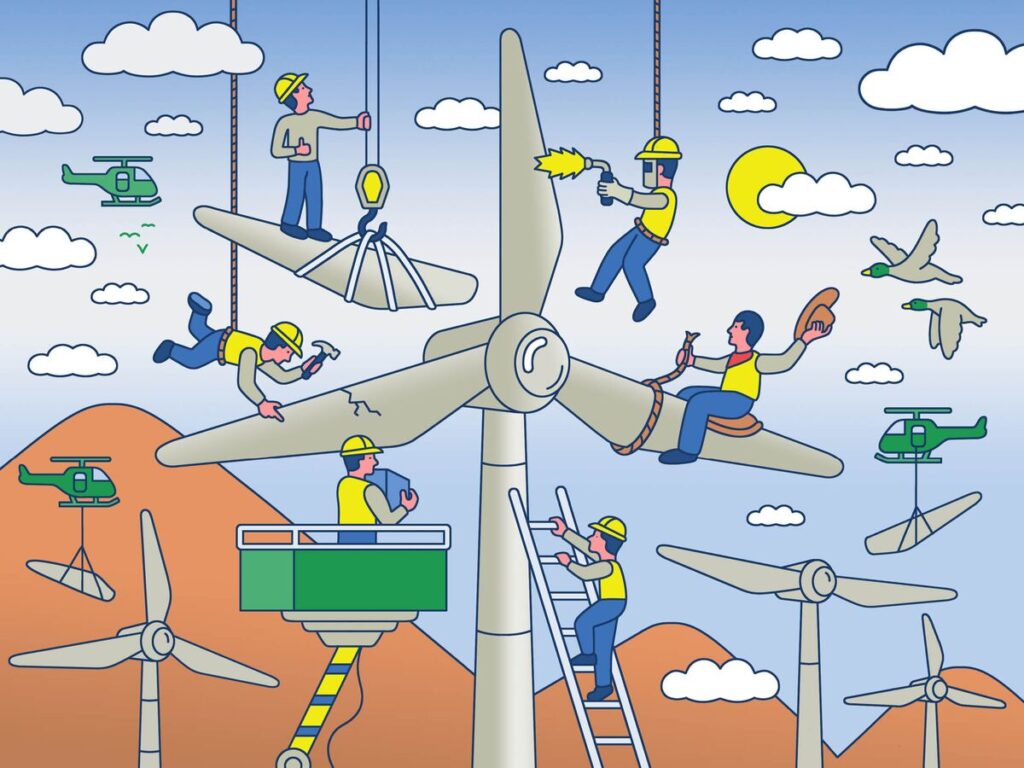Wind turbine technicians are in high demand, even with the recent cancellations of offshore projects.
For the fastest-growing job in the US, working remotely is required. But those with a fear of heights need not apply.
Employment of wind-turbine service technicians will increase almost 45% over the next decade, the Bureau of Labor Statistics predicts—faster than in any other occupation, bolstered by the federal government’s renewable energy push. As makers and operators of wind farms expand training and hiring, experienced technicians can make about $80,000 a year without a college degree—though they must be willing to travel extensively, endure extreme weather and lug 50 pounds of gear up long ladders to confined spaces.
“That’s our office, 300 feet in the air,” says Omar Rubalcava, a 33-year-old service technician with Denmark’s Vestas Wind Systems A/S, the No. 1 turbine maker. “I was never scared of heights, but when you’re 300 feet up you get a reality check,” says Rubalcava, who helps lead a 36-person team that maintains 129 turbines in California. “There are times when it’s windy, and it’s like you’re rocking on a boat.”
Job postings for wind-turbine techs in the US have risen sixfold since 2018, according to data tracker Revelio Labs, and recent industry difficulties haven’t slowed the pace. The sector has been battered by soaring costs, higher interest rates and supply chain bottlenecks, prompting delays and cancellations of offshore projects that could have employed thousands. But there’s more than enough demand from onshore installations—which make up the bulk of the $16.4 billion US wind power market—for turbine companies to increase hiring at a double-digit clip. And industry experts say offshore wind will ramp up again, too.
America’s Fastest-Growing Jobs
Projected growth in positions, 2022-32
Researcher Wood Mackenzie predicts the US will add 120 gigawatts of onshore wind—enough to power perhaps 40 million homes—to its existing 150GW over the next decade. That’s enough to ensure “long-term stability to this employment sector,” says Aaron Barr, a researcher at the firm, adding that the only thing holding back hiring is “the availability of qualified personnel.”
Entry-level turbine technicians earn from $21 to $27 an hour, or roughly $50,000 a year working 50-hour weeks. A willingness to do overtime and travel can add an extra $30,000 or more to that. New hires typically get several weeks of classroom instruction, followed by a field certification program that lasts from 9 to 14 months. Training can include rappelling off water towers, but it generally emphasizes safety and rescue protocols to prevent or break falls. Newbies, sometimes veterans of the oil or coal industries, can benefit from experience with electrical devices or hydraulics, but it’s not required. And the job is getting less stressful, with some towers now including motorized rope systems that ease the strain of climbing.
Technicians are either attached to a specific wind farm or travel to far-flung locales. Few turbine-service jobs are unionized, and the preponderance of mostly young men doing hazardous work in remote towns once gave the field a Wild West reputation, but nascent programs aim to encourage more women to enter the business.
Chad Harrison says the job was “more cowboy-style” when he started in 2004. He was working construction in Kansas City when a friend called asking if he could make it to Sweetwater, Texas, the next day for a job. “We met a guy, went through a quick overview of how to climb a turbine, and proceeded to climb,” recalls Harrison, who over time became a commissioning manager across North America for General Electric Co., working as much as 100 hours weekly to make sure new GE turbines were ready to operate. “Things were different then.”
Texas Dominates Hiring of Wind-Turbine Technicians
Share of US hires in the past year
Harrison, 46, doesn’t climb much anymore. “I miss it, but my knees don’t,” he says. He’s now head of service at Goldwind Americas, the US arm of a Chinese turbine maker, whose recruiters—along with those of rivals—pop up at job fairs and speak at high schools and community colleges about career opportunities in wind. State governments play a big role: New York’s Energy Research and Development Authority, for instance, has a program called Offshore Wind Youth Action that educates kids about wind’s role in battling climate change, along with details about jobs in the field.
Despite the high stakes (and high voltage), industry veterans say righting a testy turbine is a thrill. “It does get into your blood,” says Neal Gyngard, a former technician who runs TCGM—short for Tower Climbing Grease Monkeys—a Utah company that evaluates gear needed by technicians. “A faulty turbine could have one of a thousand things that went down—a loose wire, or a bearing that seized up,” he says. “It could take a couple hours or a couple days. But when it’s all good, you’ve saved the day.”
Projected US Wind Power Capacity
In gigawatts
Vestas employs about 15,000 people globally who service 56,000 of its turbines in 77 countries. Roughly 2,000 of those technicians are in the US, with about 150 jobs currently open. Vestas is on track to expand its US roster of turbine service staff by about 800 this year, and the company says it aims to add as many as 1,400 newbies annually in coming years. Hiring “ebbs and flows, and right now we’re in a flow situation,” says Vestas recruiter Derek Murphy-Johnson.
The ebbs, though, can be painful. In May civic leaders from Atlantic City joined executives from Orsted at the historic Carnegie Library to launch Wind Power Ready, a job-training program aimed at recruiting technicians from residents of the downtrodden region. The initiative was part of the Biden administration’s plan to boost US offshore wind power to 30GW by 2030—from 0.04GW now—with projects capable of generating enough electricity for more than 10 million homes.
Some of the trainees were slated to work on Orsted’s Ocean Wind 1, a 98-turbine offshore project that was to power a half-million homes. As recently as mid-October, the company said it would start five months of training for two dozen students in early 2024. But on Oct. 31, Orsted pulled the plug on the project and another one nearby, leaving the fate of that inaugural class unknown. The company says it’s assessing the plan and has been in touch with the students.
Orsted’s pullout leaves New Jersey with just one contracted project: Atlantic Shores, backed by Shell Plc and EDF Renewables North America. BP Plc and Norway’s Equinor ASA have also taken writedowns on US plans, and power developers are battling everyone from state regulators to fishermen to the military to keep offshore projects afloat.
Add it all up, and analysts say Joe Biden’s 30GW target won’t be reached anytime soon. But that shouldn’t deter prospective tower technicians. Despite the setbacks offshore, “the hiring won’t stop,” says BloombergNEF analyst Atin Jain. Jobs at sea-based installations “may not come as quickly as one would have previously hoped,” he says, “but even offshore wind is a growth story from where we are today.”
— With assistance from Ryan Beene


